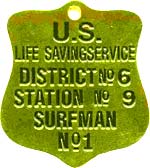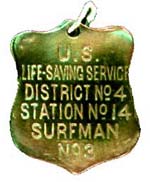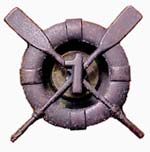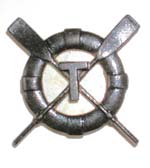Surfman Badges and Insignia
“Surfman” is the title given to the lifesavers of the U.S. Life-Saving Service and its successor organization, the U.S. Coast Guard. They have always been regarded as the elite of the two services, having probably the toughest and most dangerous job in the organizations. When most sailors are heading for shelter, the surfmen are heading out to sea to perform rescues under the worst conditions imaginable. Today’s surfmen attend extensive training at the Coast Guard’s motor lifeboat school at Cape Disappointment, Washington, at the mouth of the Columbia River – home to some of the most treacherous coastal waters in the world. After two years of various training courses and on-the-job training, surfman are entitled to wear the badge.
The Surfman motto: “You have to go out…you don’t have to come back.”
U.S. Life-Saving Service

Emblem of the U.S.
Life-Saving Service

Badge of a USLSS
Surfman (Position 1)
assigned to the station
at Poyner’s Hill,
North Carolina

Badge of USLSS
Surfman (Position 3)
assigned to the station
at Island Beach,
New Jersey
In 1915, the U.S. Life-Saving Service and the Revenue Cutter Service were combined to form the U.S. Coast Guard. With the creation of a new service, insignia, uniforms and titles were changed, although the lifesaving mission remained. Keepers became officers in charge, managers became commanders, but surfmen remained surfmen.
U.S. Coast Guard

Emblem of the U.S. Coast Guard

Early USCG
Surfman Badge
Note – crossed oars
instead of USLSS
oar and boathook

Number indicates
Surfman
position 1

Significance of Letter
T is unknown – possibly
indicates trainee or
temporary qualification
(on display in museum)

USCG Chief
Petty Officer
Surfman Insignia

USCG Brass
Surfman Badge

Current USCG
Surfman Badge
(on display in museum)

